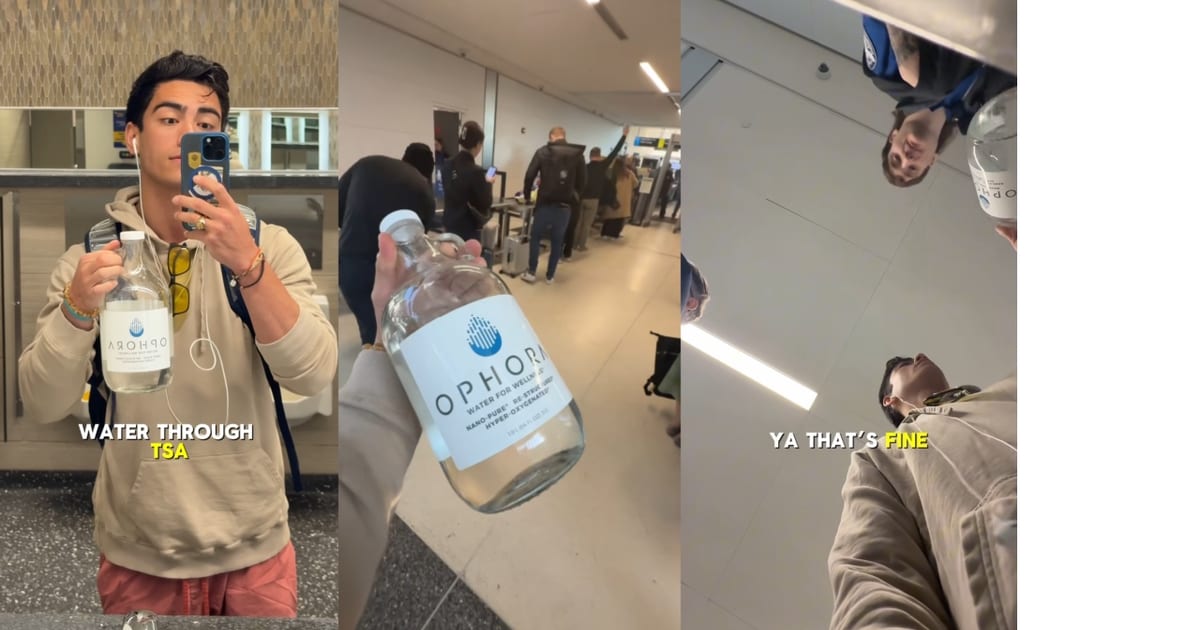An Instagrammer says he figured out how to get full-size bottles of water past Transportation Security Administration checkpoints.
“Here’s the greatest travel hack of all time,” Mitchell Dante Saron says in an Instagram Reels post dated February 16.
Then Saron, an Olympic fencer whose usual videos feature extended gazes at his Olympic-level abs, takes his camera through an airport TSA security checkpoint and asks an officer, “Can I get this tested as medical water?”
Cut to: Saron is now through security, and he still has his jug of water.
“Don’t share this with too many people; otherwise they won’t let us do it anymore,” Saron tells the camera.
Saron’s video, which now has several hundred thousand views, is by no means the only social media post that advises travelers they’ll be allowed to carry water through airport security as long as the liquid is verified as “medical water.”
In his Instagram caption, Saron writes, “Remember to fill that jug with reverse osmosis water and some salt based electrolytes.” He does not specify, however, whether those qualities are what make water “medical.”
So does this hack work?
Saron was carrying a heavy-looking half-gallon glass container of “Nano-Pure, Re-Structured, Hyper-Oxygenated, pH Balanced” Ophora, which sells for about $25 a jug but is not labeled “medical” on the manufacturer’s website.
We asked the TSA’s public affairs office to clarify its policy for us.
The government’s response contradicted Saron’s apparent experience.
“Medical water is the same as purified water and is widely available,” the TSA’s Lisa Farbstein told Frommer’s by email. “It falls under the liquids limit. It must be 3.4 ounces (100 ml) or less and fit into a 3-1-1 bag if it is being carried through a checkpoint.”
Information from the TSA’s website does seem to allow for greater amounts of liquid as long as you can get the officer on duty to permit it. “TSA allows larger amounts of medically necessary liquids, gels, and aerosols in reasonable quantities for your trip, but you must declare them to TSA officers at the checkpoint for inspection,” the agency advises.
A 2022 fact-checking investigation by Lead Stories came to a similar conclusion. The site quoted a regional TSA representative who implied that, depending on the situation, there might be some wiggle room if you’re clearly in need of a specialized liquid.
But don’t count on it.
“A passenger would need to identify that they have medically necessary water to a TSO [Transportation Security Officer]. From there it’s a case-by-case basis situation whether they test the water for explosives,” according to the TSA rep in 2022. “The final decision rests with the TSA officer on whether an item is allowed through the checkpoint. Example: A TSO would not let a passenger bring a 16oz bottle of Dasani water through security just because they claimed it was medically necessary. We would recommend that any quantity of medically necessary water over 3.4 oz. be placed in a passenger’s checked bag.”
That advice comports with the TSA’s established protocol for handling special medications and equipment for travelers who need them, which we discuss in depth in this post.
Presented with the seemingly contradictory TSA advice from 3 years ago about the permitted quantity of water, Farbstein’s reply was as flat and clear as Saron’s beverage of choice:
“We treat water like water.”
So according to the TSA, it doesn’t matter what kind of water you’ve got: Don’t expect it to be allowed past airport security checkpoints in quantities over 3.4 ounces.
Perhaps too many TikTok-obsessed travelers have tried this slippery hack recently and the TSA is trying to mop up confusion about its policy.
We don’t know what Saron or those other social media posters said to persuade the TSOs to let their water go through. Just don’t try passing off your basic hydration flask as “medical water”—unless you think you have the charm of Saron.
